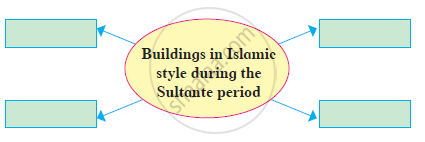Topics
First Farmers
First Cities of India
Chalcolithic Villages in India
Vedic Period
Janapadas and Republics
Second Urbanisation in India
India and Iran (Persia)
India During Mauryan Period
Post Mauryan India
Changing Times
Kingdoms in South India
India, Nations in the Northwest of the Indian Subcontinent and China
India, Sri Lanka and Southeast Asia
Delhi Sultanate, Vijayanagar and Bahamani Kingdom
India During Mughal Period
Swarajya to Empire (Maratha Period)
- Swarajya to Empire - Contribution of Sants
- Foundation and Expansion of Swarajya
- Maratha War of Independence
- Administrative System Established by Chhatrapati Shivaji Maharaj
- Release of Shahu Maharaj
- Peshwa Period
- Swarajya to Empire - Art, Architecture, Literature
- Swarajya to Empire - Trade, Industries, and Social Life
Notes
Alauddin Khalji and Yadavas of Devgiri:
After Qutubuddin Aibak, Iltutmish came on the throne of Delhi. After his death, his daughter Razia became the Sultan of Delhi. She was the first and the only woman to ascend the throne of Delhi. After Razia, Balban was an important Sultan who ruled Delhi. Balban- The sultan of Delhi believed in Superiority and was the first one to introduce the festival of Navroz and he even encouraged kinship in the Sultanate. He gave up drinking wine because he had the fear of his enemies conspiring against him when he would be in a state of intoxication. No one in the empire could marry against his will. Dress code, etiquette, and royal attire were prioritised by him. Two royal transitions important in his rule were Poibos and Sijdoh/ Sijda. He maintained the spy system and had surveillance over his enemies. Balban patronised many men and one of his favourites was Madhavcharya of Dvaita Philosophy. The Mamluk Dynasty was succeeded by Khalji or Khilji Dynasty. Out of the many Sultans of the Khilji Dynasty let’s focus on Alauddin.
After the end of the slave dynasty, the Khalji dynasty came to power. Alauddin Khalji attacked Yadavas of Devgiri and collected enormous wealth. Devgiri was a prosperous city in the South. King Ramadevarai Yadava was ruling over Devgiri. Alauddin attacked Devgiri in 1296 C.E. Alauddin conquered nearby provinces of Devgiri as well and collected a large booty as part of the treaty. Alauddin sent his Commander, Malik Kafur, to South. There were political and economic reasons behind this campaign. The most important reason was to subdue the Yadavas and to collect tribute from them. Alauddin had increased his army in size. He was the first Sultan to set up a permanent standing army on a large scale.
After the Khalji dynasty, the Tughluq dynasty ruled Delhi. In this dynasty, the reign of Muhammad-bin-Tughluq proved to be important. Mohd. Bin Tughlaq was the first emperor to abort Sati System in India. The shifting of the capital to Devgiri and changes in the coinage system proved to be the major reasons for his failure. He was the first Sultan to issue copper coins. As a policy matter, perhaps Muhmmad-bin- Tughluq was right in his decisions. However, when it came to the implementation of those policies he overlooked the ground realities such as transport and communication, adverse effect on the trade, and resultant unrest among the subjects, this decision became unsuccessful and he again shifted the capital back to Delhi. The prestige of the Sultan and the kingdom declined due to his erroneous decision. Taimur (A Mongol) invaded India during Firoz Shah Tughlaq’s reign and that marked the end of the Tughlaq Dynasty after Tughlaques came to the Sayyid Dynasty. Sayyid Dynasty was succeeded by the Lodi Dynasty. Ibrahim Lodi was the last sultan of Delhi. He was defeated by Babur in the first battle of Panipat and the Sultanate period came to an end. He had earned many enemies because of his nature. His Afghan Sardars also went against him. Daulat Khan, the Subhedar of Punjab, approached Babur, the ruler of Kandahar and Kabul, for help against Ibrahim Lodi. In 1526 C.E., Babur defeated Ibrahim Lodi in the first battle of Panipat and the Sultanate period came to an end. It was the beginning of the Mughal period. It was the beginning of the Mughal period. Baburnama – mentions about Babur and his invasions, details about India.
The attack:
Babur won the battle against Ibrahim only through strategy and not military force because he had a small army of 20,000 people whereas Lodi had an army of 1 lakh soldiers. The strategy used by Babur was that he decided to attack Lodi at night just to create confusion. On the battlefield, he was ready with cannons hidden amidst bullock carts, had poisonous arrows buried in trenches, and kept weapons on standby. Mughals were good at archery. The same strategy was used in the battle of Kanwa. Humayun (Babur's son) was a good ruler but SherShah Suri (administrator) sent him to Iran because he was too young. It is believed that Humayun died because of a great fall. Akbar was born during this time but couldn’t rule well because he was under the control of Bairam Khan and Akbar was only 13 when the second battle of Panipat took place. The last emperor of the Mughal Dynasty was Bahadur Shah Zafar.

